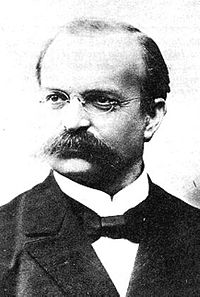Carl Ernst Albrecht Hartwig (14 January 1851 in Frankfurt – 3 May 1923 in Bamberg) was a German astronomer.

On 20 August 1885, Hartwig discovered a new star, SN 1885A (S Andromedae), in the Andromeda Galaxy, which was the first supernova that was ever seen that was outside the Milky Way. He is also credited for the discovery and co-discovery of three parabolic and hyperbolic comets, namely C/1879 Q2, C/1880 S1 and C/1886 T1.[1][2][3] In 1882, Hartwig observed the transit of Venus in Argentina.[4] During the 1883 observation campaign of comet 6P/d'Arrest he found five NGC objects working at the Strasbourg Observatory. In 1874 he became assistant at the Observatory of Strasbourg, 1884 astronomer at Dorpat Observatory and 1887 director of the Remeis Observatory at Bamberg.
The French Academy of Sciences awarded him the Valz Prize in 1902 for his heliometer observations and work on variable stars.[5][6] Lunar crater Hartwig and Martian crater Hartwig were both named in his honor.[7][8]
References edit
- ^ "JPL Small-Body Database Browser: C/1879 Q2 (Hartwig)". Jet Propulsion Laboratory. Retrieved 12 October 2020.
- ^ "JPL Small-Body Database Browser: C/1880 S1 (Hartwig)". Jet Propulsion Laboratory. Retrieved 12 October 2020.
- ^ "JPL Small-Body Database Browser: C/1886 T1 (Barnard-Hartwig)". Jet Propulsion Laboratory. Retrieved 12 October 2020.
- ^ Hockey, Thomas (2009). The Biographical Encyclopedia of Astronomers. Springer Publishing. ISBN 978-0-387-31022-0. Retrieved August 22, 2012.
- ^ "Séance du 22 décembre". Le Moniteur Scientifique du Docteur Quesneville: 139. February 1903. Archived from the original on 2020-12-15.
- ^ "Notes". The Journal of the British Astronomical Association (3): 143–144. 1903.
- ^ "Lunar crater Hartwig". Gazetteer of Planetary Nomenclature. USGS Astrogeology Research Program.
- ^ "Martian crater Hartwig". Gazetteer of Planetary Nomenclature. USGS Astrogeology Research Program.
External links edit
- Short biography
- Additional data on page 21
- Neue Deutsche Biographie (in German)
- E. Hartwig @ Astrophysics Data System
Obituary edit
- AN 219 (1923) 185/186 (in German)